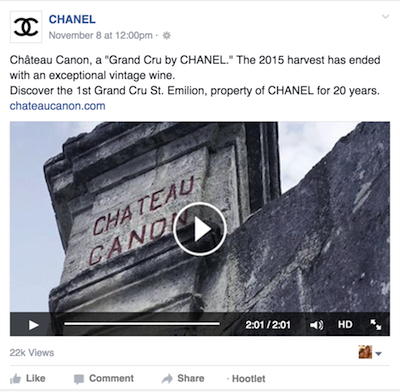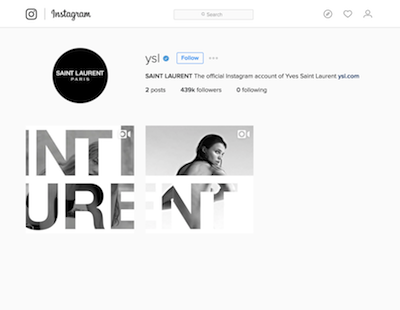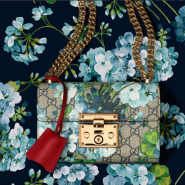Facebook and Instagram are similar to red wine and white wine, according to a study of the two platforms undertaken by Facebook.
Besides using Facebook for news and keeping up with friends and family and turning to Instagram for inspiration, users also generally look for humor on Facebook and unexpected encounters on Instagram. Just as one would prefer red wine with steak and white wine with seafood, both platforms offer unique advantages suited to separate purposes.
"Brands are continuously experimenting with what works best for their brand and across both platforms," said Helen Crossley, head of audience insights research at Facebook.
"Advertisers often ask us to describe Facebook and Instagram to help them understand how they are similar and how they are different," she said. "These findings are an avenue for marketers to get a better understanding of the nuances between the two platforms and their communities."
Red and white
Approximately 20 percent of Americans’ time on mobile is spent on Facebook and Instagram, evidencing their marketing potential. For those who use both equally, Facebook satiates desire for empowerment and connection, while Instagram satisfies the want of fun, relaxation and discovery.
Interaction on both platforms is tilted most heavily in favor of close friends and family, but celebrities and brands are higher priorities for Instagram users. However, Facebook is bigger for person-to-person interactions, presenting brands with the conundrum of visibility and engagement on Instagram, but better viral opportunities on Facebook.

Chanel Facebook post
The uses, which contain some overlap but also notable differences, are a testament to the importance of engaging consumers on both platforms. Additionally, marketers should attempt to meet consumers in both their “inner and outer circles.”
More discretely, Facebook’s study showed that at events ranging from the Melbourne Cup to the Super Bowl, the Cannes Film Festival and Glastonbury Music Festival, the most popular Instagram posts are of a behind-the-scenes or celebrity-focused nature. Facebook posts, by contrast, received more likes and engagements when they were heavily opinionated.
It follows that brands should use Instagram to share behind-the-scenes and celebrity-driven images, but use Facebook for reactions and other more opinionated posts.
These generalizations must take into account demographic information as well, from gender to age to nationality. Men see the platforms as practical communication lines and say they boost self-esteem, while women were more likely to look for connections – indicating they may be more receptive to ads.

Millennials are more likely to be on the platforms in the day than older generations and also seek video content more. This is amplified for Australian millennials, who are around 50 percent more on Facebook and twice as much on Instagram.
Gen Y consumers also say they are more likely to interact with fashion and beauty content on Instagram and Facebook, furthering recent inclinations that Instagram is the ideal platform for reaching a young, fashionable audience.
Parents tend to pick up the habits of their kids. Parents are as likely to look at video content on Facebook as millennials and more likely than non-parents to follow brands and other businesses they love on both platforms. Like their kids, parents use Instagram for celebrities, fashion, travel and beauty.
Brazilians are particularly active on both platforms, outperforming the average in nearly every component, making the market particularly ripe. By contrast, Japanese Instagram users see it as a “diary” more than a social platform and are less likely to share Instagram content to Facebook.

Yves Saint Laurent Instagram
Although the same creative can work on both platforms, tailoring content and modifying ad spend based on target market and according to region can help brands improve their ROI.
Spotting differences
Third parties have also conducted research hoping to identify platform-specific best practices.
As Fashionbi detailed with a recent report, social media is no longer just a tool for reaching young people.
Although those in the 16-24 demographic are the most prolific users averaging active usage on almost four channels, those in the 35-44 range also have multiple accounts. Simply being on social media is no longer enough, as the diversity and popularity of myriad networks requires brands to calibrate more detailed strategies.
Fashionbi recommends Facebook as a platform for showing off products and marketing the brand experience.
Until recently, Instagram was the organic alternative to Facebook’s ad-driven platform. Engagements were 10 times as high on the photo-sharing platform.
In March 2016, Instagram followed its parent company’s lead, introducing an algorithmic timeline. While it remains to be seen how the new model will impact engagement rates, similar strategies will likely lead to similar results.
Instagram’s community is much smaller at 500 million users, but it skews young, international, namely France, Italy, Sweden and Russia, and toward fashion fans.
Individuals naturally respond more strongly to visuals, making it an ideal platform for products, inspiration, celebrities and campaigns. That versatility in turn is the impetus behind the move toward ecommerce, prefigured with Curalate’s Like2Buy (see story).
Similarly, L2 has identified Instagram as the better channel for interaction while citing Facebook as optimal for reach.
With Facebook, measurements of reach have subsumed the importance of interaction through comments or shares. Interaction has dropped and brands are posting less frequently, but posts are getting more likes and more impressions as videos and posts are promoted through paid advertisement. Accordingly, media dollars in Facebook have jumped.
Instagram, on the other hand, is a platform for more frequent posting and organic reach, supplemented primarily by shares. However, Instagram's recent shift to an algorithmic timeline has somewhat curtailed this tendency, and saturating the feed is no longer as effective. Nevertheless, posting more frequently has not curtailed engagement; consumers’ activity suggests they are not fatigued but rather delighted to see brands they follow posting more often.
Facebook has also emerged as a hub for videos. On Facebook, a view is registered after only 3 seconds, or 10 seconds if promoted. On YouTube, viewers must make it through an ad and 30 seconds of the video for a view to be registered, thereby resulting in comparatively tame numbers (see story).
"We’ve found that brands can achieve great results on both platforms using the same creative," Ms. Crossley said. "But by understanding the nuances between the two platforms, advertisers can develop creative that speaks even more strongly to their target audiences, helping to drive meaningful results."
{"ct":"bfVidzp5mmJsuSjKLfgOA9Ot8RX\/boz7fbsh3vVN0gJY2fozcIY5AIKG1ZNrEQ\/nLPe6xZ666B5tsC2X6CUEL\/pO6rfcGtg9duz4fnCX+ky\/xyqpIXCgVDJxT1Q3qIEXfzgHNddpNIVra4dalbvViySCdAnhr68tJWLurGzTcK9I6HtfoMlwb95rxe8zycnv0XWH58E7GS8EeCzsalLc0A\/aj0xjpcC4EP9T5pSnzXgs4sJJd101BP+gHUaviwPeVNQm9fBP8fY0k5sVEKfS7dK48S9TbCm3IXQhmOil9mBfI50pHUCAjf8kTsysZMCRDB6V2Vztgp5jg4WvoC7xayeulaOKNWHPdeNONTU1ZtX5cOqQvWgPYpvxvIXQcHCZJbDlmiEqyt+kCRtgVYz12lxkQ9VvhRcMZ+3S1pwGOI539bKuqGOR9UkFqhcuXwbYWumMWufu29z5H0z1+fOorcamAUuCYeizWkCuiEqomgu8ui8xd2i2+wsJpjTPHUJXhz6oF0zdHEEDPmYsNrbVMJBuw2ogG1v\/N0wA6iXoRYia\/rnIjV7l3gJrHvuUiQy7b0ojj6L2Vn2TF9VICohQh8GA6iE0QAK8Jbd6TLOGxnJKG2zR3gcsML6Z6AO13DpmnxVySLD+sxexSKll6d+pTb2di0yTa7oYdmdZXFNah4dKm79DVk2l0oaZ3NYeAYsSNIkiJdhY5b8dBtW4lrf\/IOW5CDAV7iaEzt9a1bPkPHY8w3U10H9ooo\/cadzN94fcQkwa0kWA2BWhxjHhQvXvGEzFK1o6Q0NG9hni8YLgtajfk4b+aMsGkX6veXggkAWugB7t0XkS8Kul2jGhqc1ocBGAx\/Q6BJyO5uZXGQsqTpqitToPaNW9Ytdqx\/8sIqLHaYQODw0i8KxyJi2uefy\/kEF\/6pntFX91oI2Bz3LPqTbX8mvn4DvnVRj966GP9WWiS5Jjv6+9ii9cOh0Sxp0KhX2Gv3osPJSZiFuV0hpsP9cH7XRWaLpF2d7wbGjD65+gWCqf3+m+l3RyKLosXN1g3DSMVdTPQesrUAHolNs0LpfyYspTog8Sn+Hs8UsDLY50byzVcZpDcO2ACDCV\/pYi8aiHFfkUd+829nQa3GUSM1wgangNZmXI790UjGV4zQrey8p8s\/ZwOg8p4Ro8aBIKg5XqO8HevdqbBPSFzBXQFSWn4\/8reEShPafpLUSI2y+PBN7l4gyb4B3hgn0fcDW+OJbYs\/USDetMrDRqKSduZckpevxLlqpdlKufpoSjz7\/3n6lh4Gr09w5Ri0x\/kItMBxeDBrAUphQHV6bMjI62o48OALi++3hBxFnVfdXAE5++KygzjH6vQapY1C9NA1AS+7t00TqtlXUDiD6M57uXCYzrfrvbF7aiUG9mJpPfJMQZMRxayRAk8q8OxaT0gq\/7m7RVyjr63fIsq4tpg08m+ujqxHg7nJQ+d1Sm9E62e+YFGQPZNI3SxRBntU3ZG6XBWnq8efs1D1BkVxpIm322\/PfYOd7Ebh7\/SfJeTxJNDPtexP+BgKOUuJkJRd2ycybvreYTN75EH56lJvN\/9eCHo0R+p+cUopW5XCa+88JCYqb9pO4FpjTN6sLhWYkm6SF16gnUySlJQFcrV6z6Y5LDIGiSWTV5O+eWEwrseclhUIt81KRHRblA1MvP6kb9VAhwlAl\/Mo6F929aeDH3WsYWYyMJtLfmmRXJqmrXLMUi9WJIkhA7afXjkYO3krfUh4GbW1gXKwYGGUcGPzaTh3Fs\/Nz4ZHvHepldY4+fGKPNrlEl1K+EffJX3JM+gjdBGyOgEfAkEwM8guge1Ip757u0yuU53TdCrxfCKlmqWRFZv+4RJGNc4laMHASzh1TC56gu7O\/8mBI966OXZ\/FyadOLRGPHx6QBu+SwGi4YR+oLtIp7Jr12mNPq8lMPmH2ZtWtBEanfCpC\/heSt9P6ZWOodBpl9DolK5a\/+tvvyrTb661tmbdjVxEwYGUEmihBL\/9KVw\/XAIjkV9k5Ci1ofjUrKCV8zZt+rsbAOzwhne9XadF\/d2Di7mgH87ZHRujyhtf2g8lgHzEAAfJZoKi81hQIIyBRLLijdwwVmHh0BnG8VnWhwX6Bf7DwK1r1Cp\/d2Y3K3SUZTK7PXjFiVaOA5ecwyA7xBRVnB5cFMi2KV\/mOxbIw39Ygb7KDi6LdZz9jzDkmIAcFyS3ZBC2wIHqocVUK\/yLtKrST2SLXSaQyG8EmLrFCVBJ3IDd2BdLrpg3sQKjDKEJeC0aFp6HEL\/OPcJSG7KY+mt+G\/m+\/FtF+e\/+xaoQAaED2ayNkL9A0cFOaByCzRYWaCma8lPMVFetFbo8R6LOk+OpD+1YTIxcTsXS3Esiq5P0pbp\/kCnRF+7jdPRkwz\/bOGPPEdy0tziD2wE45LRayZiFG2PRyR9G+npPw+\/S\/bXL0ITeqomlZkXl9d0g+dsUnVklGAzrwOsdNg4\/7i5OpGed6rhbPfkIYWn7rxjhXFqDOet6hv41+P8Uv\/bG5XUeYEU5AYUWPlqVhsKaRqlVBSjCX6L5sLxhfF1bBJfJnIm9z9RDMqm8NMuHgR3gfrvI2vz+EhSNuqeO3FCOdYBuInSi0hNve9IiPLaKi1e6oo3up9wsn51+s23AKKRAplsHxd7+WD80Fv\/UqO5wX9+FW1ZGgp\/xr\/gUiNdyyjIawezxqpdh9PojRli3te682h+CS9FBPro+xX4cwcDUBbnjtyBYKcCSx5hHEVbVIljYID7Gf7oahQ29+ahq+cmvtnYj27iBxURU6ktuAOa6H6bUUnwA26kQTmhNowtwj5ywS3OTZHApksrfLLw6mwd22LZbwUMIggZi2MUhhdWC82roc4g+lxpUU7S2lMSWEwfeccTLCuqqA+xrsoKSrcd12htgUpNGjz4A3cNI7vD0cgmt9Hk2etV4PNuZhvxDizVJtxKqkT6TDb5yGHkWgWnfaXpBnvYejwhASDDl\/KTPRJe3KRo0vFJnCqGfiHAT04cdY0oXufBxRHuhuPhIIx+IHIbUCLBzecrsTBLO9wSy7\/FClX3Y0e9W9YvcvUxsp8M1AVwxly5gXLQRp2sXiI1GcL62qOR3\/zvG7U55eloEmitPrbdZe0dPFoH+\/4K3z0kgOb0+rfYQciowy+4pnEULqpkIvwoNTIEBblNNKUq3m6Fytt9LwZgoYsnGpnpjNSulInblkZE0XOci4k04e9WKHO8\/7s3J5rW\/1z8d8tTLWd4hNCLaamBbWqMAG1DtIFXrfvi3w+XWUkt0iEKnm+EFkcmn0g4NoFpof\/VyywDTvxwOV\/58EwqVi+UXOYaOs+Amh1uybs7E+jQ8B3BU94jLjn1Wv1fi7ID5duJFaIPovJG1FvjDkrubzzygmRdaHcOiUbwL22B4wlhfEDSnrU03bUZamTNVQOi3AtW9c\/OvumWmYKIszqY4kLTjSvs2BPuX6wnIf7x\/xdsxhavF2jj8m6IrJSaA5rmAgM2lMGlYCXu\/QCEpF7MrVK3eq5+eG22Wlp17lZhiSJYfM2koCvJX95Me8WasIYtFaU+RP60p\/nTv2eRZQzJhw\/GQ2fJAWKzSUrrUIMzQJb0npjRGkBeGmTSz2HToG1jTfztZ9q6z2UTOe0OIvLe3f98oqrbipAVE8PHzqaQhejXl+ICAJa2DLfjjWPaDJ\/A7pw8VL1GHk+ibfNtmtvYj\/POZxZOStVCj5lNkRZL0u2hqKN1gXKHLtMHAN9Ty5MSxKaBiM189cCZuzVMdaMos6i4\/o8MLc0t1RspLMRwvPAbTRWdmtnk3e66r7E6bL8eOiIkqp8uuMOyabxVH6ay\/nHQZ7LPEfpOa7x\/zkPlVkD3nk0CeXUpRGEEgyVzs6W3iJIruN2CyUiah\/tb9qdWt32eXiC9H3RYYho47auf0ZA5EuQRSA6KAERCNUGmwuIbj3\/OmYs62AI0vIgRIZeQFF1N8uYqYPVGrVhcexNZpt4htAcRwpuCtWvWxTzJQa44+yUBLz8bKR50pwHwCMz147ER0XXERZWx3vuizPOb4GhZ1LTkAPxyyVgoXXp85jqXFn84DSBCmCJq+Nsxt9pylDyneqJYr2XdVNUrqzMODhaLla87usxShkyNYvhRvUqqxnA\/j30TxtXBze8F6dqd7Xr0Plsg4lt3N9Wi8ffpjdHNEKSBOIJ+nNJEWO+8E50pbebGCUeiEJzpb7OToaWMrHzxQpL0xMjTUDROf6JtxQ2femtRDQLEDZ2w3XqJz+EXjO3Wxy3U4R73poWvLOUQlzqibu9fddOciZBiPP23PSaY9cWeOxh7daaG5q7a9z21I1JLA14l5EM4fjKB9RaE\/izm8h\/mJdzOjvvU3b7SU9zelzoK1pAju5yLvk3iYCTKIBAZGXJm1+l7UGjUh9r40J3AKvZpTYFRoeWxxb+z\/xJVeTfCWoWi94O8JuhKfC7oXeOH2x0q9TaurBCaSkCvbddFCPsIvAm4hpXuAuKpQx2Rj6vKy+G3KGjbv+75ZwEVLa0sGEaDAZx4D5Wi1cyr5X8TmiAes9CKmjY9D2cgm3AOGp58VpLcausg9kYSUZ4k3NdLWtYWDnQ6hcj9EjJ6fOYffudvCDkYl2NnfRSdryD+kKX9PXfZUY79XlOTTjmfwXNZbxLACuWbssCpgdjhfgAce06PiXSftgxN7r7rxVWmt8df7DJAIhXZUX2kgXGkOL\/Dz0wtiECMxM\/maqLg7GlDwB4pr\/cO59kXPwvH87GxXsVM9ff3OlALFjG7YbcsHiU\/WTP7WNYTg6WfgLiFtQYFgXjX9YKAt+hp2DgtNPGWUXgSV3SBX1MQ3WC0zlUd6Cc6AW1LsVSJsJl\/HBpFcueR7lCFWCJm\/H1JpI4xiCHUKEV9LWCQmAJkdckFqPldUOsOiGOWfhXH5Jk0OS0En8maDvjLMrdEOsQ4KBCr5MCo7vXnHwpuAagdd1h99S1Una+b6RBBH0cUWapcNM\/OO4bGDh1M+V\/2mUyarzFJqqZFOhOsDxazEaQynkZXn26hrbo91RTKaiC+LuahaPN4OLM7t3NqrbK9UXSeR2vgkEjJ5l4Hdo9iIAu1ISgJK\/ZxWkNFGmP5UNfMM8jfangs\/pCOg0ASjeaOGZ\/4pb6vj6Uh36u1pISM4wM5mKHhmwmzzooYajic5gh2ZhVFN9GAolm\/m1TU+Uhq\/oryVRrEuwpIK1gRpO7MynkQYFofzoSCVTEmAJ5xxFJDt+2yaO2f1TF784MDkni6Tcv\/ocAEZno8hnKRPirTjc\/kOJQl+sls\/ndk\/4yxNopboWSX9r4p+x2Icz\/dnD8Cf+NIzArGDMD8By2ETntdRcU\/dPg+eFjuUTFmS+28kVjEbSH76G9y5BMo4t1MS6C4PvUsw0bLwnASt59EHlBs1EkD+0Yg\/G7faz2oBw1JtIpgyL5nWCBuHJ\/uLXt0RpRxT3wj5XL+hR0rFUjrxtLWXO17fydjaER2Agyd2K45+wYMQaNhb54WysSNGvFS+hU2na3BO9jykYF9N8h1VEKv33LF7Hb0fqElAMcy+h+Bdi8RTnO7Reovj9MdPbEx1mNolte2b8VZ\/JkV9S48yeC8GijDtefxtuNVCSqALWYUmI8Jnb+DJQferyuR1+R1ZDmRK2zcRp+GKCtrhGqR9wes0yJmDkCubfN2WWciUZgefGXfcxbW1PrkbJOCnnnwKzxIG9p+b1u1dtwEuB2hqAO3AwJA6iY3ASCehSAdj1HwKc9dFFR9rCQ009CpfOXQ+91LZqE9AQGssdcKisSsQ\/q2ReV0m4mwHmm0y\/2ybWESp+3CI0XAj1JN6S1QCMHzMkEKk6eQoO5urBquQfiqhx3j13MYxyJIWx5SOPvZ\/DfcVfcsZnX3QNGkWI2yMivrwflje4pX+l3E\/y8a5zwiIIgKJiMjtr6fAwUOvE5fLIWyaUZRa7JSDJf93zFm1I7G05UlXAGaV14OKZTjtIOiZUEQcP26C6x5eZYgT9AYAek7ppsVW4SjGUFgXAcqE8rcwPAfr6MptTL0fsKiv+DuIp7FdbCCrUVvZK\/2f\/85qpJcR+UymhIRo7aoY4AucD\/Y9vhzY3uXDOXTxlnz5nMXDNWTH\/0bDC2UsBc\/qqTqhfO7lkJFZy0u+bV0TLki0rz9sF9w5NGGwVPkqT1uypNCpvYK25lzz3OYYKTfm4hZwCwoD6deqKJMo5UUPD9HYy+fOpNc1FgcQzBZ\/ob8CXV8G38DH3l+GlslTvnc\/zyZT+ctPjZPRfYiD5sYvMW5JmsCsdZhnMXQlxH5UFjuelY5Nh5YsnZ2iYehBqXog9Iud5Mc+Cf1cWpvvyO9+5YFFnTo3UHvUv03iqnEY80P2iqXi8B5xYS6igV1slkiGym5vypkLSsh1PqPXQMDw1DrIw0kd8QpaHoAgmIBEX38EaN03Bc\/kxu2Gk4ZvcGFSqhLTJyyb4mP+aCzKXH16Z3H44fTVCg1JPR8EGl+5lK7EXH3pm\/kZqBbzOlfGw+nSw1xAPw30qOoWgtoR50TwL41yx7+Rl0M5RXWJoAVuh2dQrWj8V2yUE\/F3yR6R2OH9NF5W7jDL7npqgvy3v0y5pSTGFtP5avT+VwNkuKUnd8Ui9W9lIFkWri\/rKpTlNa1Yh60wyiuqegO\/Alt2avbQsbBCXVuEAzyoY0oobdcZGZXUj9sy5VBmMrX8xkky3aFUxmTUk87uUHWZiPOxa6Yorl9Ah03XPR1HKPTxUdkR2vt3UeSum4k0cMNHUm8rql75wCuNGa5xLyrdMWSNyMBPxFNKLSpgEr1jEePDpvDYgDeARzCjXYzKwDLe2uOdpKM+biffY1UPJUxd0yrZJEWx\/5EmQFAFX\/UOWhGNctwai28kUTCZgWanbWVrfOK+ZyQIil5HWxf8azroEGHd3uaTmlNfcTjysStHAFYGOktW0xCuXRnk+uNbuL9ZVDOmNpxAs3ay46CrBVzDUpXgxJ3EkYPKQyDAnC8qxKdyv496QawU89ugI7WLYovDDkmVQG8BWVT5wYaKAxBBxYnRv9Ugx\/AGp7RhsZvywF7h6jPDMNtyupVIKwte5XgDHE6wtVWZRjB+lPrxS5mzWk18tlSx9Yu3bvT1w1cdjwTjVK2k8xbrCJHYma5YHtVLhoYEz1g8g46Uqi\/Y5UJe5U3kJI9n08scyBvRdrCW8OS+dJDvzHBboOmkyQrV+X4XuyY7nJQp7vneYXyeG\/49iZdQL+JFUR8WjqwJku+XGkTDU\/LHn34EyTCB2WIJy85dtdX4BNlJbVQ1Yhq8Mg3+Cy81AJiwkfjQJHSBvDzXSErGkwanyF8R5o4H\/L6Z2rm4\/g6GFQmje\/JWYE+N7kfeWkjurOSpx9\/B+OssfHpz\/OCOrvyxK0aWLNNr3UUptl55iMq4dHwTJLpgfz4bbJtLzBd2ZLKzLlQG7nlqucaKg6LvTectc31xkn9q9RjcGUnXgXo08GexeSeAbH9c92s4koGM24V9GYc8VNYvVHyweQToWYarLg5\/CQOB1IZEI982ypqLRIX9X\/asRC5\/3H29HMudcjc3+dD5bkPstatjvntbA7\/H0gPlcXDd5nNjjJ1mT3+WsyBfPMnd841NJOMbTd1Qj+AgrFRsrdvlV6UWMtGhorJUjoAHbbkDoFevXHeWBsMEMhJwxWOkxC5VuBvwsiyRnrbF9qaqvhGaUqOvm3PgXkYvMsZcRecqA35AXTi+cnqTjHdKpOGhzhxwlKKFji9M6vTnFkUa4rKLiS4y8l+Sy7q4xe17g17fG+FWWFvrTfSzcxqhAxKWtSME+gCUk\/mDFivQxdbKc2EIaf3Mu8Cl+juwIBVWSwDhEudyHWaXGWM13pFd4GOGWWFWQlGe1zzr2uZpf4TEWxFknJ9V\/uuVobfIVT2NprYGBN9+jSdRPiLo9dpyJJUGHPYJGUqIqci7u2f4sH9yd1ceGSchEzqD4u0rGveYIAiDd3s6ZL5Ca5ESSRfm2R459JO10AzfST3S0JDNzdwzQhaR5paEoMEiYiB2xOW26nybEvZzEqkMhAG1vAi8XttlesCsuzb8lOmOywSoPkIOH+S2yY7qgaGqo46FYC9zk+ZWUcfmCKDIMLxuUINdOud2r9QKVn6BQ\/xv37XrsS5XOaYQbtoO1MiEO53D1kFm33Xs9nq\/5EveOFeHWlthj4rTSFUlP97TdZkuc5r5e679BlBHMeZCHILHmS04ZwlODHKK2v+Ku0hsnRr4myM9lcMshW6xMYOwgTQHog2HS31RYDRCV9CMbb5gvUKazf3gAkJa+1LZDuaaURRCP4+u8vrNMYXhN+9h0C5VRgc8Z3nJJV4ighNgobJlUWzisGH\/rOkNp7B21EgnTmb0mEycBBTYAiVyA4py+DIB3JrEqWopTDNsUJ2PmGLLUkh4wHwZZMDoFHoAPl5JmFZ5m1Qfx8+xoKP6+F1hzTjVrGb\/xdJBIKu+uIJc\/O258w8goxL\/R6PUEtmo3qMPuQ1J8mKfzNO1j0GH2UU4i8X\/PY5KhBaxebVi2DiaOT6u8z9RXvnzC8RlTIlZJWOACIC08a4+jUCMvXMFOSbEVE4HZofbhpUhhWkPdBXQEt7AN6oz0hvq9KxRv+AhmJkNtMotHSy7um7D660rB8XSV6eQWsttmI9FizmNWJZxNSIZz8M51E\/\/S16q83ZCydbRKYzUr3uQBYt7KMgyWH\/G3fk79KOriGaOJMEAkCw1\/JPjPkkEybv7Xm7GHsfYmu1AgW7dzYI68D6H5tQvDZGPQMCzWPIYRAAKzFWLjHvFW9FXc5bvmGMzcJc\/4U81X4iJpOXtuZBdcK5TCiugn6iM1D8rnOt\/20ZB5PK5tsaysa8Lz3CIwQkoYKjjN2AFj6qhlnx0SaNCg1QvMfRYUqA44qRGSFBpTHOpOEiSgI1o\/klTN+R8UVOFoaifRNnwMsbhYPBLNTxbv6h+a\/X6mb7AZjjmlPYlqY\/neYjCI+Q+gCITSiEVl8266OgmLbME2P8kzcFBlfd+ELgqNdu48TianKCfysHKbgHFAWEG\/rAu9S+AHJIuSGld6m2LKbxTKemWA+vJGYhWGgC0VlUtvHG9uyfCV5nat\/p1OuRVjXNiSyP\/0hL0IAUH2\/YcKndujDaGdsM2mNFVey68MEDcELA07Uh91KXsvDlMXuYtvHg869hXRlYFF2VqjaBA+9mWGfif\/ITvAPHYUTIuYtWTIT1o1OHMEzz1BWOEGltWPylxzzZT5M2yH2yTxRwfInwtggv9khGodMTYhuivCiot31\/RjQdy2oNRL4yu42G1jVQmM6+uqZ8usuFwsuN7IUZ3WXLRRu3ehx3FfubiLhG1s\/1UYyRU0btZ4jodgl+tT2Xfc05\/74UmVu9lGHNfDfmD3ZOyH7ebrM\/qB1xCDKgJyNNfLrjW3x2YhPQ6zrDh4ts+x1I\/Jme24Lpd5EuP6cg7dWtM6dCzfIJEXwPs1YD4oHxaEaAqG14\/SWI41p2dlfAdph2V1FHhipQ73TjVcQPacAySgZRlNIkZisfNevpmw+ISh9Iv2jlTrsStqxKhsMCfwDaLqlydTdfakZUsUHptyTaJHYUDgfdDkWSmBe0p7Hvk0rEM7ROLwvuOkS5dcGcmUmx9izJqICf2HOCj3sEp7ZwCi15m4s0ZydML+lNNixtmKx0r+nxXp9vyzuAaOezLFhC8G3zFlwjHrSvCDDLG8O79on7xaasnlhjmndft1ZxUPJY3Zmn1U4VLwmu2xGQucZjhhwK6aHGO0A4n65jW4f7o3d1qh\/rRJgVeEB4HxwZ\/ubwc1ewQnND5kNN2JTZYCOTpuKv+h3dWBdIdoVnKgw4z48iAzHqC+hvw7eOSpT6hKNwvlG0nqF34TYjMcnzFyCLOGo\/+dEh0FBDEkiOGqLAZd1QiIzNk1dGGkTCvLiOYvKBVRq4BNDXhvQo8w\/glNbU2bT5TkHWmeUeDlvtFDhcHmtj4peUCmBirBiYdmTMptTDh1IzRMnuU1T77h1yq2QLOwjzBkFy57wFnQRJWfWM5w6w19DWgrFLMA9BPYM+mASVlyRPjRcE+poubh+q2bdWxXi00s9y20xcJPVsEEv+LYVabhhvIeVL33t19C0bxOqEuc5KXI58UWlupscel8FZz3+zquN5NgcxTSlmSJ+Th0nWHOKbLx8n6De5Makby3A645vKWKKnTwuVXBiAA9ePctelqZGRA3lZQrCtkvAhdQ94CuEnFO9mrh1Fvom\/l7TZg8zNzCH8LCKL4sCZaOlJonm7wPYdRhpTuXN9q7UE+I07QOUWwfaCI7gk\/ZSKZfWaC3A51ApL8pZEaUkVXPkOqiRvTvJmN2f4pUtSI8fJk48fxewtoxUpk\/QK1jBxnWKEJcavT3J2J0ssnNxJLqH6ZJHIRzcQA9OsxZ1UY0X5jjzROGA1EWDlyJzBBIR1FznQMbcjf72bn6p4BvQ6HrTpwi9gnQBV2h2Qn+QbH7E0vUNUH5800uPXrVW3tQhlsgT4FzRjwXCKTy6rx2qdptKWP8oJouUBJRHxebAYR4xdT6nfty5\/XhnMhXgtfzYhuNDg7vFoKGylnx35wKLMF0ptwfw9T3EH9Q5CaDesJ4ZlEZvu2BkmTK2gY8Nvvmdeq9kWY+EWQxN51Rl6k0vXLmhyCCr213G6la8DDRUvuqt31aEgaFJl4htOeBATQ9Yg23OEhX4MSKzxv9N+vKssq4LZhZngx+ovefbFqKdk4yaxQrzNP1z+UR+zoaAc2AL3Mkl5tsbAQc6TWc\/NL2Cf0fh8QpJ11LikhoH2InhEs84sPBHxlv5E1RNv5d9p6scB8CwZtjk0n7yHI3ynTQZhIMtSdhb3REP2UIbx09\/ONbxsq\/fH4Xz3FDz8pYhhSP5dhg4ljNI+X6G14wigREE9SRNmLxmIlgrvknNzpNNf523X5kRQGqIBL69DiQnzBcA5yXCNL9gNTQL0W\/daJHbl\/rId3Hcw3wz0iggrCPiKHJRVOMM\/X8+e4nvYhGSsEf9vysFVRR2bi7n8U+uzQu+opPSt\/qYcIg1wKEfIDKy7RXdC8IDYgp7GhX4HWEAyuSjpPjM1QwgDB6g9tg+Zc2WvKn0T8iPnEA4LdDmPTuQj\/0inKy2Rtk+i8b3GDGYloOfnZxhMm9vkrvfIbCe3Y0aak9M89o79cQNaer30bRTJ+Lq45pre1lsqnJC8EmYZwxPMwGBhG4edlkLahTmMKFy0VOnCKiiunCEskhMp5SD7QdFv3h1H1ILaEc+eWPgl2HyjjAK0ZJ5TDYEpzdiS4pkGjXVpXkSHTOFW\/k4T3dECeBAc7WCut0sCLQpy+qiXbsqm+B5VvxAHEMAZkp6lciYW4AjTRAw9sc4NDKBJm60wUpCaN5YcN9B1VCutroIOPZRJB+e+lKdgKUwgU2bW2V5EwSD5ImkrcKseninWWBuv85iI89AhYK4NjQkRhdiXqLUHF7V7\/tIM2pNwNAG9IXfVtD9pmr66rTl5x8mXxJN1Cw5lmjK66ckTEe3qGBigN9Kujuf6n3Ax8LLNghY9nyjAlBMfmwcQPL6IbuIY1UHqY00U2qDfO6KOzu4w1zHRpehW+k7HHIzfhhJ2ZKAi\/Ey45+1c4Lm153hljTQMmzmYZlUEmxna7hRjuXxMUXCFaKXIiPDJlSgyLhHBeLpaPyv55WZJFMCEKQbfhcstaZ5f1OHCi+qjCjDnwtCKQoV+RDjUHtv0Q2UQq5g8IsWrQErNuYzBvVfEACrvfeGg39ztte++C3MQ9eC1tH2zY9C7lHSA0ng9yeUcsWdcn2b5I3dbYiueoRyd8G1\/hj3IdCuCBYIGg==","iv":"8a3b3194b621f4efefa5822f27a19829","s":"e426f797ed5f3741"}
